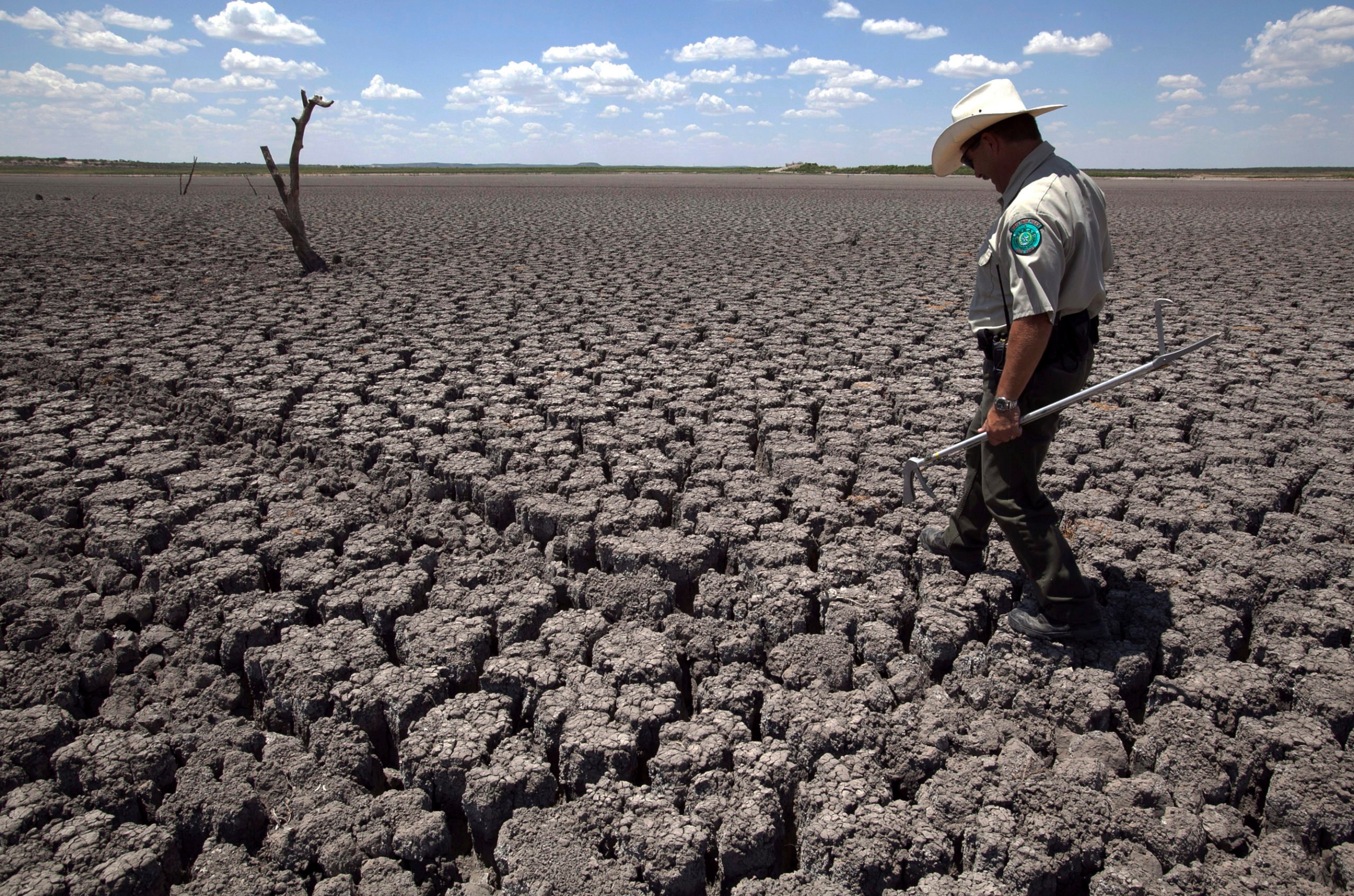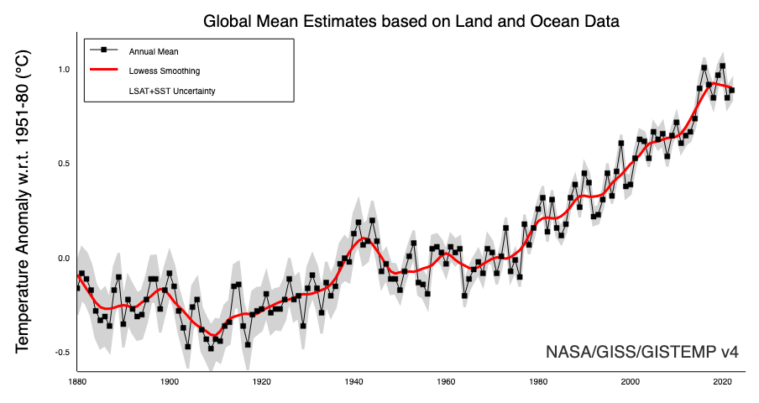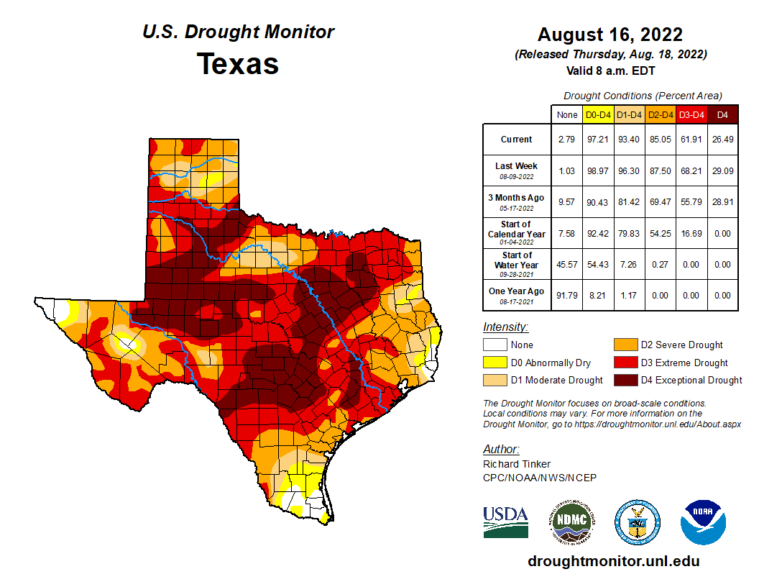
A Hot, Dry 2022 by the Numbers
Our record-breaking summer provided a preview of what’s to come.

Last year, Texas experienced climate change not as a single disaster like Hurricane Harvey or Winter Storm Uri, but through a slow burn of increasingly hot days and nights. Summer was brutal: The state baked through its hottest July on record and its second-hottest summer overall after 2011.
Globally, 2022 was the fifth-hottest year humans have recorded on Earth, according to an analysis released by NASA on Thursday. Using a different analysis, researchers at the National Oceanic and Atmospheric Administration (NOAA) ranked 2022 the sixth-hottest year. Overall, scientists agree the 10 warmest years on record have all occurred since 2010.
While troubling, this news is unsurprising.

Climate scientist Andrew Dessler at Texas A&M University has a tongue-in-cheek auto-response ready for journalists each January, when estimates of the past year’s global average temperature come out: “Every year for the rest of your life will be one of the hottest in the record. This in turn means that [2022] will end up being among the coldest years of this century. Enjoy it while it lasts.”
Computer models predicted an especially hot summer for Texas half a year in advance, according to Nathaniel Johnson, a meteorologist at NOAA’s Geophysical Fluid Dynamics Laboratory.
“Certainly, climate change is one contributor,” he said. “The long-term trend in temperatures is one of the sources of predictability, something we can anticipate many months in advance.”
An additional factor was La Niña—a natural climate pattern involving Pacific Ocean temperatures and atmospheric pressure above the ocean. The presence of La Niña during the winter leads to abnormally hot temperatures the following summer, particularly in Texas. La Niña’s average warming effect, however, is only about 0.5 degrees Fahrenheit, and temperatures in Texas from May to July were 3.8 degrees above 1991-2020 averages.
“I’m still trying to understand why last summer was so extreme,” Johnson said.
He thinks the pure short-term randomness of weather plays a role, but reiterated the long-term effect of more greenhouse gases in the atmosphere: “Every year that our greenhouse gas [emissions are] increasing, that’s going to contribute more to the warming.” So far, the Earth has warmed by about 2 degrees Fahrenheit since the Industrial Age, when people first started burning fossil fuels in bulk.
17,000 Emergency Room Visits, 170 Deaths
The extreme heat had serious consequences for Texans’ health.
Those who could cranked up their air conditioners. Peak electricity demand on the ERCOT grid broke all-time records not once, but 11 times this summer—eventually reaching more than 80,000 megawatts on July 20. (In addition to the record summer heat, population growth in Texas also drove up demand.)
Not everyone could cool themselves. People without housing, people in prison, people who can’t afford air conditioners or their energy costs, people who work outside, the elderly, and the disabled are all in danger from heat.
By the end of September, nearly 17,000 people visited emergency rooms across the state for heat-related problems, according to the Department of State Health Services. That’s far more than the 10,000 heat-stricken people who ended up in Texas emergency rooms during 2021.
Deaths related to heat, though, may have declined slightly last year. As of September, 173 people died in Texas with “exposure to excessive natural heat” on their death certificates, the vast majority between May and August. In 2021, at least 198 people died in Texas with heat listed as a cause.
Because the state’s fatality data relies on death certificates, these numbers are likely underestimates. Last year’s count does not, for example, appear to include the 53 migrants who died trapped in a tractor-trailer in San Antonio at the end of June. While the Department of State Health Services provided this data, officials did not respond to a follow-up question about whether they included migrant deaths.
Fourth Worst Drought, 650,000 Acres Burned
In tandem with the deadly heat, last year was exceptionally dry. By mid-August, nearly all of Texas was in “extreme” or “exceptional” drought, according to the U.S. Drought Monitor.

2022 was the state’s fourth-most intense drought on record, said Texas State Climatologist John Nielsen-Gammon, citing the Palmer Drought Severity Index (which combines temperature and precipitation data to measure how extreme a given drought is).
It’s difficult for scientists to draw a direct link between climate change and lack of rain in Texas, Nielsen-Gammon explained. Global warming does, however, exacerbate drought by increasing evaporation from soil, plants, and bodies of water.
“You run out of water in the ecosystems faster,” he said.
Dry soil can in turn raise the air temperature, causing a vicious feedback loop of heat waves and drought.
These tinderbox conditions contributed to a rash of early-spring wildfires. State and local firefighters responded to more than 12,000 individual wildfires over 650,000 acres total in 2022, according to the Texas A&M Forest Service. The Borrega fire on King Ranch in Kleberg County and the Eastland complex fires a little southwest of Forth Worth, which both began in March, were among the 30 largest wildfires in Texas history.
56 Percent Less Cotton, 2 Million Cattle Sold
The drought has been especially hard on farmers, ranchers, and the larger agriculture sector.
Upland cotton production in the state was down 56 percent compared to 2021, according to a report released Thursday by the U.S. Department of Agriculture’s Southern Plains office. Farmers did produce more pima cotton this year, but Texas grows far more upland cotton than pima, which comes from a different species. Corn, soybeans, sorghum, and peanut harvests all suffered too, according to the same USDA report.
The state’s vast cattle herds also shrank over the summer. By the end of August, ranchers sold more than 2.6 million cattle for slaughter, 480,000 more than in 2021, according to the Texas Farm Bureau.
“That level of cow herd liquidation hasn’t been seen since the drought of 2011,” read a news release from the organization. While experts attributed much of the sales to drought, the Farm Bureau pointed out that inflation and rising feed, fuel, and fertilizer prices played a role as well.
Torrential rain at the end of August flooded the Dallas-Forth Worth area, but brought some relief from the drought. It isn’t all over, though. Much of the state remains concerningly dry: According to the U.S. Drought Monitor’s weekly updates, 28 percent of Texas is still in some stage of drought, while another 21 percent of the state is “abnormally dry” but not quite in official drought.
After a short cold snap in December, temperatures rebounded and Texas entered 2023 on a warm note. The National Weather Service predicts the region will stay warmer than usual at least through the spring.
Temperatures will continue to rise year-over-year unless people around the world stop releasing greenhouse gases into the atmosphere. The Biden administration aims for the United States to stop its greenhouse emissions by 2050, and the Inflation Reduction Act passed by Congress last year is expected to get the country about halfway there.The law’s success depends in part, however, on how willingly Texas and other states embrace the switch from fossil fuels to clean energy and efficiency. While solar and wind are booming here, in 2023 state leaders seem determined to not only keep old fossil-fueled power plants online, but invest in new ones—and set new temperature records for years to come.


